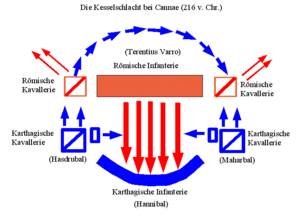Battle of Cannae
41.306388916.1325Coordinates: 41° 18′ 23″ N, 16° 7′ 57″ E
![]()
The title of this article is ambiguous. For the second battle of Cannae, see Battle of Cannae (1018).
Battle of Cannae
Part of: Second Punic War

Second Punic War (218-201 BC)
Saguntum - Lilybaeum II - Rhone - Ticinus - Trebia - Cissa - Lake Trasimeno - Ager Falernus - Geronium - Cannae - Nola I - Nola II - Ibera - Cornus - Nola III - Beneventum I - Syracuse - Tarentum I - Capua I - Beneventum II - Silarus - Herdonia I - Upper Baetis - Capua II - Herdonia II - Numistro - Asculum - Tarentum II - New Carthage - Baecula - Grumentum - Metaurus - Ilipa - Crotona - Great Fields - Cirta - Zama
The Battle of Cannae took place on August 2, 216 BC on the slopes of the Murge near the mouth of the river Aufidus. The Carthaginian army under Hannibal destroyed the Romans, who were outnumbered by 16 legions and led by the consuls Lucius Aemilius Paullus and Gaius Terentius Varro.
Due to Hannibal's skillful tactics and the magnitude of the victory, the battle is considered one of the most significant in the Second Punic War and went down in world history. To this day, it is taught at military academies as a prime example of a perimeter battle, and the phrase "suffering a Cannae" represents a crushing defeat.
Today, the former battlefield can be identified between the towns of San Ferdinando di Puglia and Barletta in Puglia. But the exact time and place are disputed, as there are no direct contemporary accounts. The oldest account of the battle is by Polybios, who was born about fifteen years after the event, but did not write his work of history until about seventy years after the battle.
Previous story
At the beginning of the Second Punic War, the Carthaginian commander Hannibal led his troops and war elephants across the Alps into northern Italy. He inflicted painful defeats on the Romans at the Battle of Trebia and the Battle of Lake Trasimeno. Fabius Maximus was then appointed as their commander, but he avoided any further open field battle with the Carthaginian army and allowed Hannibal to pass through central Italy without engaging him. Fabius Maximus aimed this strategy at having the Carthaginian army exhausted due to supply problems. The Roman population disliked this seemingly indecisive approach, so they called him cunctator (meaning "the procrastinator"). In 216 B.C., two consuls were appointed in rotation with the express mandate to put Hannibal to the sword, since he had cut off Rome from its vital grain supplies in the south.
The two consuls Lucius Aemilius Paullus and Gaius Terentius Varro took turns as commanders day after day. Their actions immediately before the battle also expressed the different characters of these two individuals. The tactics of the Romans - when they finally faced the Carthaginians at Cannae in Apulia and only the small river Aufidus (Ofanto) separated the two armies - fluctuated day by day between cautious action and brash drive. On the day of the battle Varro was in supreme command and, according to present knowledge, led the Roman troops on the southern bank of the river. This terrain being hilly, put the cavalry at a disadvantage.
Looting
The scale of the armies involved may seem unimpressive and one might be tempted to assume - because Rome eventually won this war - that it was just "another wound", but Livius handed down a picture that shows how devastating this defeat was for Rome: Hannibal had his men collect the gold jewelry from the bodies of the fallen lying on the battlefield and sent this collection to Carthage as proof of his victory; the collection was poured out before the Carthaginian Senate and was estimated at "three and a half measures" (6048 pieces). A gold ring was a sign of belonging to the upper classes of Roman society.
Search within the encyclopedia